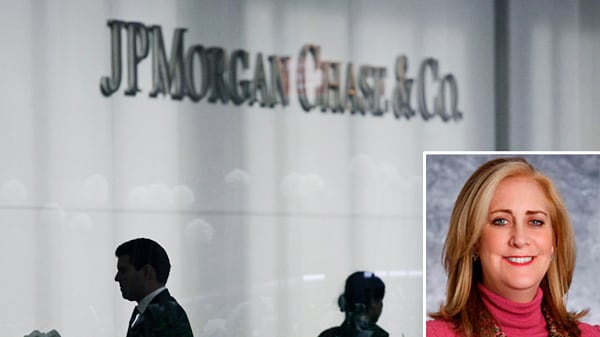Last July, Ina Drew, the JPMorgan Chase & Co. executive who had toiled for 30 years to become one of the most powerful women on Wall Street, found herself in an unlikely place: at the epicenter of Hollywood glamour.
She and her husband, a periodontist practicing in New Jersey, were honored guests at the Capri wedding of Ryan Kavanaugh, the boyish 37-year-old credited with bringing Wall Street money to the film business and financing such movies as Cowboys and Aliens and Mirror,Mirror. At the time, Drew was in talks to buy a chunk of his company, Relativity Media, for the bank's portfolio, so Kavanaugh invited her to sip Prosecco and nibble pickled aubergine with Bradley Cooper and Leonardo DiCaprio.
But a mere 10 months later, Drew, 55, has found herself the center of a different kind of attention. On Monday, she resigned under pressure from her perch as chief investment officer at the mega-bank, painted as the chief perpetrator of a scheme that is likely to cost plenty—as much as $4 billion and the spotless resume of CEO Jamie Dimon.
Drew couldn't be further from the image of the young rogue traders like 30-year-old Jerome Kerviel, who was accused of wracking up billions of dollars in losses for Societe Generale in 2008. Nor does she fit the stereotype of a Master of the Universe with a Fifth Avenue duplex and a black Mercedes SUV idling at the curb.
Instead, according to sources inside the bank who have been barred from speaking on the record, she is a quiet, hard-working mother of two who lives in the New Jersey house she and her husband—they met as undergraduates at Johns Hopkins—bought in 1988 (for $750,000, according to real estate records). Despite the fact that she's earned more than $15 million in 2010 and 2011, making her among the top five earners at the bank (and one of the best paid women in New York in any field), her idea of living large seems to have been a $375,00 one-bedroom ocean-view condo the couple bought in Palm Beach in 2003. Her kids, Alexander and Sarah, are in their early 20s.

"She is as far from a ruthless diva as you can be," says a former JPMorgan executive who worked with her for 10 years but did not want to be named. "She's just a really smart banker and a nice person, completely unobtrusive, very trustworthy. She made the firm a lot of money for years. But then there was this one bad bet."
Granted, it was a doozy. Dimon originally admitted to a $2 billion loss due to the complex trade that was executed by the bank's London trading desk, adding in a subsequent statement that the hit could double during the next quarter. By Thursday, the loss had already grown to more than $3 billion. Sources inside the bank said that the losses were mounting faster than expected because the hedge funds that were on the other side of JPMorgan's bet were rapidly exploiting the big bank’s mistake. The complicated trade will take weeks, maybe months, to unravel, sources said, leaving the bank vulnerable to more losses.
JPMorgan, overall perhaps the best-managed big bank in the country, will still make a large profit this year, probably upwards of $10 billion, analysts say. Even this quarter, including losses due to the botched trade, the firm will probably make more than $2 billion.
Despite the image of high-paid bankers as flashy screamers presiding over trading floors full of caffeine-fueled young bucks, many of JPMorgan's top executives are quite the opposite, insiders say. "That's old school," says a former Salomon Brothers partner who now runs a major hedge fund. "A place like JPMorgan is as varied as any huge institution at this point. It’s very corporate."
In fact, the bank, which has 235,000 employees worldwide and is the largest in the nation when measured by assets and market capitalization, has been cobbled together over the last decade through many mergers and acquisitions. Drew, for example, is technically an employee with 30 years standing, though she started in the 1980s with Chemical Bank, a brand that was subsumed in the 1990s by the acquisition of Chase Manhattan. In 2000, the combined entity bought JP Morgan, and in 2007, it scooped up the ailing Bear Stearns.
In addition to Drew, the bank has let go several other employees who worked for her; JPMorgan has announced that the so-called “London Whale,” trader Bruno Michel Iksil, will be leaving the firm. He likely structured the elaborate trade, which was meant to hedge bets made on the direction of the European economy, and may be the only one who can help unravel it.
Dimon, who came to the bank as part of yet another acquisition, in 2004, of Chicago’s Bank One, has gained his stellar reputation partly by being able to cherry-pick smart executives from each of the silos of the business. "He has a small inner circle to whom he's unusually loyal," says one current executive. "He choses people based on talent, not a certain personality type.” His inner circle includes both flamboyant, socially connected characters like vice chairman James Lee, known throughout the business as "Jimmy," a patrician 55-year-old who came from Chemical Bank and is considered the father of modern private equity, and Jes Staley, the soft-spoken head of the operation’s internal investment bank, who many think could be Dimon's successor one day.
Drew is definitely not a colorful character, sources agree. "I hate to say she was non-descript," says a partner in a European private equity firm who has known Drew for more than a decade, "but she's definitely someone you'd walk right past in the lobby of the building. She was very smart, but she didn't say much." One trader who worked with her for nearly two years can't remember her sharing a single personal detail. With many of her trades stemming from London, she was often on the road, he said, but never complained about it. "She had high standards, but she was really smart and great to work for. Everyone here is very upset because she was well-liked."
Drew is credited with helping steer the bank through the shoals of the 2008 downturn and with having cannily snatched up some of the shards of Lehman Brothers and MF Global. “She made them a lot of money,” says the European private equity partner, “and Jamie was acutely aware of that.” A few weeks ago, as the size of the trading loss at last became apparent to Dimon, he was wracked with concern for her, according to the Wall Street Journal. He asked fellow executives who were pressuring him to fire her: "What if this were your sister after 30 years of great performance and you said: 'You're out of here'?"
Despite her gargantuan salary and bonuses (which Dimon hinted at the company's annual meeting on Tuesday might be the object of a "claw-back"), Drew doesn't seem to be either a conspicuous consumer or an eager philanthropist. Her salary would have given her entree to the board of any cultural institution she eyed, but she didn't seem to be interested. Her only board membership seems to be Johns Hopkins, the alma mater at which she and her husband financed a small needs-based scholarship. She serves on the investment committee. "She was very efficient and willing to do whatever was asked of her," says Raymond "Chip" Mason, the co-founder of Baltimore's powerhouse brokerage, LeggMason, who was chairman of the university's board for several years, "but she wasn't one to bother with a power grab or networking. Her biggest concern was that she not have any board functions on Sunday nights. She wanted to be home with her kids." The couple also donated $100,000 to New Jersey Dental School, “to enhance advanced technology in the science and practice of implantology.”
That she was female, a rarity in the upper echelons of the banking business, seems to have played no part in her firing, Wall Street insiders agree. "She was at the top of that particular food chain, so she had to go," says Suzanne Nora Johnson, a former vice chairman of Goldman Sachs. No activist or mentor, according to those who knew her, Drew was not involved with any of the women’s groups on Wall Street, such as 85 Broads or 100 Women in Hedge Funds. "It was a classic case of an executive taking the fall for things that were done on her watch. There are a lot of issues on Wall Street involving the lack of women, but there's no one who will blame what happened in this case on her gender."
In fact, JP Morgan is widely considered progressive in gender diversity hiring, at least in the context of an industry with a woefully poor record. Drew was one of two women who sat on the executive committee, along with the company's head of asset management, Mary Callahan Erdoes.
"Jamie is definitely not afraid of women," says Duff McDonald, author of "Last Man Standing," a 2009 authorized biography of Dimon. "If Jamie trusted her at that level, she had the goods. Until she didn't."






